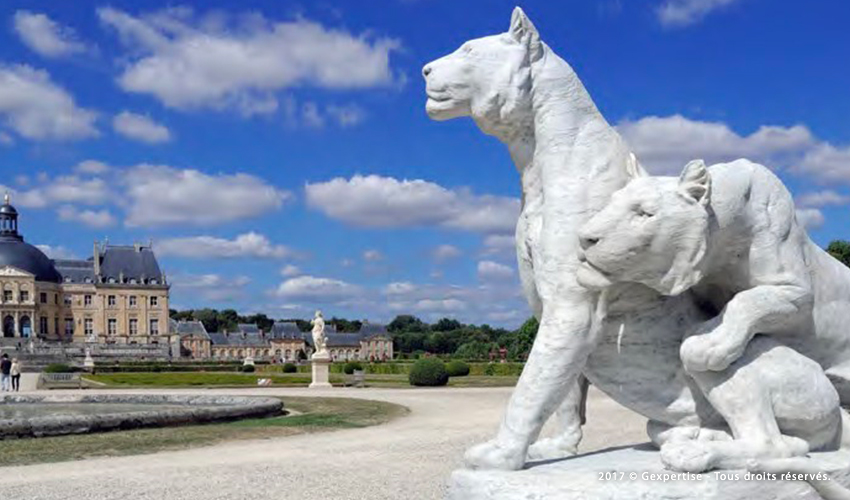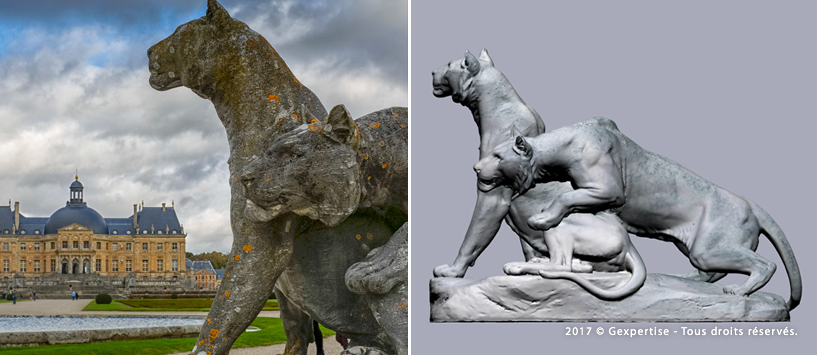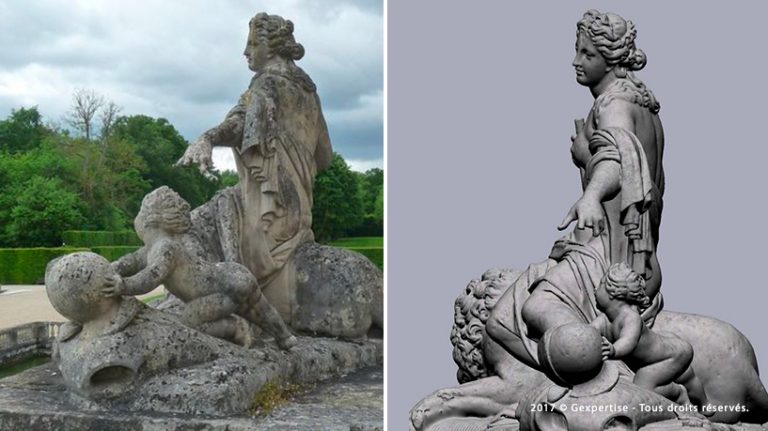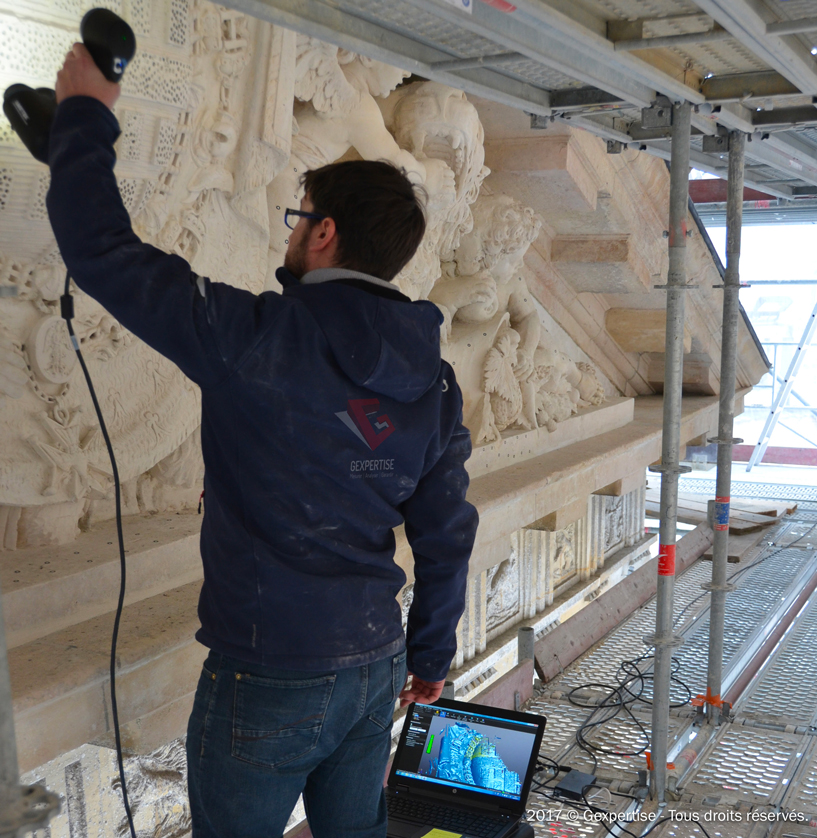Digital archiving of works of art: 6 incredible opportunities

The Vaux-le-Viscount Estate is a masterpiece of classical French architecture and art.
Built in the 17th century, the Vaud-le-Viscount Estate is the brainchild of three leading artists of the time: gardener-decorator Andre Lenotre, architect Louis Levo and artist-decorator Charles Lebrun. The genius of the three creators made it possible to achieve the most refined harmony between architecture and landscape, which was an innovative achievement, not surpassed throughout the XVII century. And although these creations are now an object of French heritage, artists could never have imagined that their works would once, even centuries later, be reproduced using a 3D scanner !
This monument of classical French architecture makes a strong impression on the graceful monumentality of the palace and surrounding territories. The mirrors of the ponds reflect the extensive gardens, decorated with numerous sculptures. Vaux-le-Viscount became a role model in Europe and served as an inspiration even for the Palace of Versailles, which served as the residence of the Kings Louis XIV, Louis XV and Louis XVI.
The statues of the estates are still incomparable, although they are from 110 to 360 years old. Unfortunately, they are constantly exposed to adverse weather conditions and vegetation. The state of the statues is influenced by lichens, mosses, erosion and destruction processes are underway, which threaten the safety of 61 statues of the estate. The deterioration of their condition prompted the Chief Architect of Historic Monuments (CAHM), the Regional Office for Cultural Affairs (RDCA) and the de Vogue family, which owns and operates the estate, to launch a heritage preservation campaign funded by private individuals and companies. The most important role in the implementation of this project was played by 3D scanning .

The Tigers Statue by Georges Garde (19th Century) and 3D Scan Results
The project for the restoration of the statues of the estate of Vaux-le-Viscount appeared ten years ago, when it became necessary to restore three significantly damaged statues of the 17th century. They were created by Michel Angier, one of the favorite sculptors of Nicolas Fouquet, the first owner of the estate. Since solving this problem required a lot of money, a campaign was launched to finance restoration work. According to Alexander de Voget, the owner and manager of this unique French estate, "the success of this initiative, the enthusiasm of the sponsors and the joy of the opportunity to restore these rarities prompted us to continue, and we included all the statues in the work - a total of 61 works of art."
4 priority restoration goals
Today, both individuals and companies who want to contribute to the preservation of masterpieces are joining the co-owners of the estates. The restoration program is estimated at 13 million euros, is designed for ten years and is based on four priority goals:
- preserve the garden (planting trees to restore the main natural space);
- restore the palace (namely, three through arcades to the north and south of the palace, so that visitors can see the outline of the garden from the entrance gate, despite the massiveness of the building);
- restore or acquire works of art (24 statues available in the garden);
- increase attendance and support cultural initiatives (facilitate access to the estate for people with reduced mobility).
Saving masterpieces in 3D

Work on 3D-digitization of the statue “Mercy” by Michel Angier (XVII century)
Although restoration is carried out primarily by cleaning works of art, it was urged to find a way that would save 61 statue of the estate, without damaging them and saving for posterity. The Gexpertise modeling department, which specializes in the technical study of buildings and the creation of 3D models , has helped to preserve the estate through 3D scanning: a digital archive of historical heritage was created using a hand-held 3D scanner.
“In addition to cleaning 61 statues under the restoration program, CAHM also recommended creating archives of art for tenders,” said Benoit Derio, project manager at Gexpertise. Indeed, the gradual or accidental loss of the fragile parts of these sculptures is an important reason to preserve, as far as possible, the memory of their original form and to be able to reproduce a copy in the future. This task is solved by modern and inexpensive technology - digitalization in 3D. It replaces gypsum molding, which eliminates the need for physical storage and makes it possible to obtain secondary copies for image reproduction.
Digital Archiving Features
Digital archiving allows you to:
- create 3D databases;
- make measurement and analysis of objects ;
- quantify restoration work;
- create an archive of artistic heritage;
- create 3D reproductions;
- create a virtual museum with reconstructions in case of damage.

Statues are digitized using the Creaform Go! SCAN 3D handheld 3D scanner
Contactless technology and easy 3D scanning
Under the leadership of the team of curator and restorer of objects of art Serge Giordani, which is engaged in the restoration of works of stone and marble, project manager Benoit Derio and researcher Florian Luyer were on the estate from March to May 2016 to fulfill an exceptional mission - 3D digitization of 30 statues according to plan first stage of the project. Then, thanks to a new charitable contribution, the second stage and the translation of the remaining 31 statues into digital format were carried out from July 2016 to January 2017.
“The Go! SCAN 3D portable 3D scanner uses non-contact technology that allows you to perform complex work and create a polygon mesh in software in real time. Thanks to the scanner, we completely digitized all the statues, and then processed the original data obtained with the scanner, ”says Florian.
Post-processing of the generated file is performed by specialized software to modify the resulting source simulation. “For 3D printing, the mesh of the statue must be“ clean ”and“ airtight, ”the expert explains. The office cleaned the mesh, filled the holes, reduced noise (smoothing) and textured until the files were finally exported. “One day of collecting data in the field requires an average of one day of processing, and the size of the object or the level of detail can change these dates,” says Benoit, whose functions also included advising sponsors on 3D printing. - We do not just create archives in digital form, we oversee the entire process and help our customers use all the capabilities of a 3D printerfor example, printing at different scales, or reverse engineering any part of the statue. ”
Go! SCAN 3D scanner in the hands of specialists
This hand-held 3D scanner captures three-dimensional data in color to represent geometry and textures in all their richness, producing exceptionally realistic results. This tool enables surveyors to model large objects with an accuracy of 0.100 mm. This scanner provides visual information from the entire site and confidence that the processing is complete, which allows you to not move back and forth around the site. It meets the needs for high accuracy and high resolution, which are necessary when working with such complex and demanding objects as Vault-le-Viscount.
